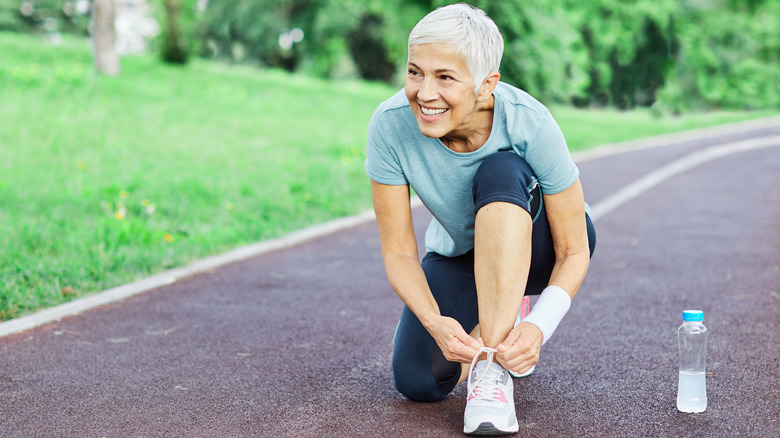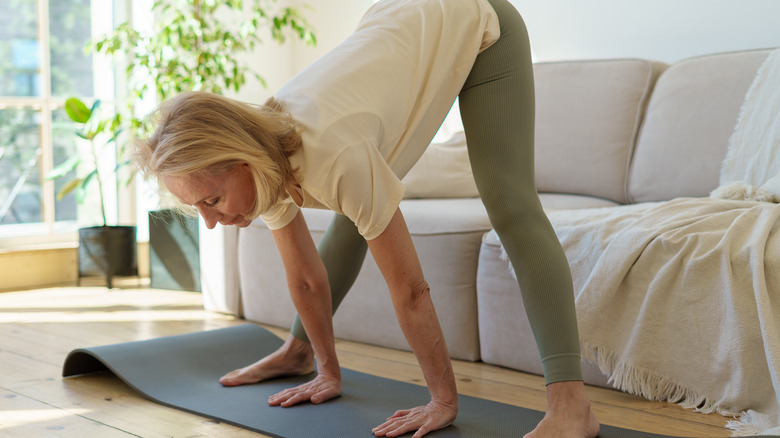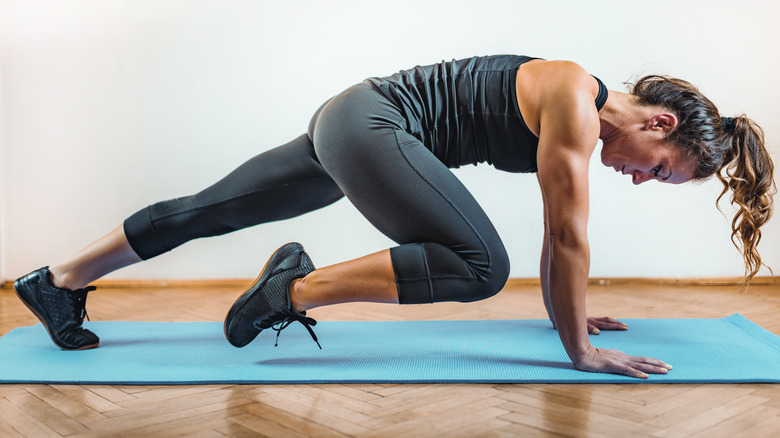Exercises You Should Be Doing If You Are Going Through Menopause
Menopause can bring on the sweats, irritability, fatigue, and even anxiety (per WebMD). But that doesn't mean you need to sit idly by a fan or avoid getting out and about. In fact, exercise may help improve your mood and provide some relief, according to Healthline.
Additionally, menopause is often met with weight gain and muscle loss (per Aaptiv). But it is beneficial to maintain muscle mass, because muscles burn more calories than fat. Therefore, strength training and moderate forms of exercise are advised to help maintain your ideal weight (per Verywell Fit). Cardio exercise will tackle those large muscle groups, too, and keep your heart rate going strong. Strength training assists in maintaining muscle mass. Exercises like yoga may help calm the mind while keeping those joints well lubricated (via Healthline). And contrary as it may sound, exercise may help calm those hot flashes, too.
As per recommendations from the Centers for Disease Control and Prevention (CDC), healthy adults should strive for 2 ½ hours (150 minutes) of moderately intense physical activity and two days of strength-training per week. To help meet those exercise goals, and to combat the symptoms of menopause, here are some of the best exercises you should be doing.
Fitness basics during menopause
Estrogen losses, increased belly fat, depression, and even night sweats in midlife are all associated with a greater heart disease risk for women undergoing menopause transition (via Go Red for Women). And harboring extra weight from menopause puts one at risk for certain cancers, too (via Mayo Clinic). Excess weight may also contribute to hot flashes (though there isn't yet conclusive evidence proving this connection). Therefore, menopausal women should take steps to better care for themselves, including dietary modifications and adequate exercise (via American Heart Association).
Before starting any exercise, it is important to understand your target heart rate and to track your progress, according to a 2011 article in the Journal of Mid-Life Health. For instance, being able to talk without breathlessness is a sign you are within your target heart rate for moderate exercise, whereas during vigorous exercise you might be able to say a word or two but not converse. Exercise should include stretching to prevent injury, and can include activities like yoga or stretching for well-being.
To keep your workouts safe and effective, ease in and out of your workout routine, and choose activities that will provide optimal benefits. Always include a warm-up such as a 5-minute walk or stretch. Choose an activity that get's your heart pumping. Good options include aerobics, swimming, bike riding, and running or jogging. Use resistance bands or weights to keep your bones strong and help rev up your metabolism. And, finally, cool down after exercise. Walking is a great way to catch your breath and relax the body.
Aerobic Activity
Aerobic activity refers to exercise that strengthens heart and lung capacity, and is a continuous and rhythmic activity that works the larger muscles of the body (via University of Colorado Hospital). This type of exercise supports the flow of oxygen to the muscles for movement and energy-burning capacity, a benefit for weight loss (via Cleveland Clinic). It may also improve HDL ("good") cholesterol. Aerobic activities include bike riding, swimming, walking, rowing, and jumping rope. You can stay at a moderate level or work up the intensity gradually by doing the activity for a longer time, using greater resistance, or going at a faster speed.
Though aerobic activities can be done solo, there are also many instructor-guided options out there. Aerobics classes provide a series of movements to get your heart going, with a warm up and cool down to ease into and out of the aerobic activity and prevent risk for injury (via Better Health Channel). Beyond that, the socialization of a workout class may help with motivation, consistency, and healthy competition to get you working harder and smarter (via Better by Today).
Strength Training
Women going through menopause often experience weaker bones due to estrogen losses, which can increase risk for fracture and osteoporosis, according to the Mayo Clinic. This is why strength training is so important for those experiencing menopause. Strength training is a weight-bearing activity that helps protect and preserve bone mass (via NIH Osteoporosis and Related Bone Diseases National Resource Center). Additionally, this type of exercise may help speed up a metabolism that is aging and slowed, and help burn that excess menopausal body fat (even when the body is at rest), according to a 2011 article in the Journal of Mid-Life Health. And strength training helps promote balance and coordination, too.
Strength training exercises include lifting weights and using bands, weight machines, or your own body weight for resistance. For best results, these types of exercises should be performed every other day, three times per week. Be sure to warm up prior to any activity, include all muscle groups, and consult a trainer for a safe practice.
Walking
Walking is a cost-effective method of physical activity that may benefit menopausal women, according to a 2017 study in the International Journal of Gerontology. Indeed, according to a 2020 review in Menopause, 91% of the 77 walking intervention trials reviewed provided at least one benefit of an issue related to menopause. Most notably, walking may be effective in reducing symptoms of depression while enhancing self-esteem, which helps boost quality of life, the researchers say.
A small 2010 Canadian study of premenopausal and recently postmenopausal women suggested that walking for 45 minutes a few times a week may help reduce a bulging mid-section, a common symptom of menopause (via Reuters). It may also improve emotional and physical health, agility, and overall quality of life for both groups. While the menopausal women didn't lose as much weight as the premenopausal women in the study, the findings show promise in the effectiveness of walking upon overall health.
Cycling
Cycling is a great way to stay fit, boost your mood, and relieve anxiety, according to Sustrans. It releases those feel-good endorphins, and it may help manage those hormonal shifts that occur with menopause. For those with tight muscles and tendons, cycling can be a way to strengthen and support those muscles, and ease discomfort (via We Are Cycling UK). Fitting in 20 minutes of cycling three times per week may also help reduce some of those negative side effects of menopause including fat gain and muscle loss (via The Week). Indeed, as an interval spinning exercise, cycling is effective at promoting muscle mass. Such resistance-building activities are especially important because muscle losses are associated declining levels of estrogen (via Australian Menopause Society). Fun fat: Cycling may be even more effective in producing muscle gain than weight lifting, as per a study from the University of South Wales in Australia (via The Week).
Running, Brisk Walking, or Jogging
Some of us like to run, others may find jogging do-able, while others prefer brisk walking. Any of these weight-bearing cardiovascular activities can help reduce menopausal weight gain (via Everyday Health).
If you choose to run, you'll get quite a bang for your buck. A 160-pound person running 5 miles per hour can burn about 600 calories (via Mayo Clinic). Walking briskly for the same amount of time burns half as much. Runners get the benefits of calorie-burning as well as reductions in cardiovascular disease factors, such as cholesterol, blood pressure, and blood sugars, in about half the time it takes to walk (via Healthline). Brisk walking, however, is easier on the joints. And you'll still get those cardiovascular benefits if you cover the same distance as you would on a run. Brisk walking can be defined as walking at a rate of 3.5 miles per hour (via Mayo Clinic) or walking 100 steps per minute, feeling somewhat breathless but still able to talk, and reaching your target heart rate, according to Healthline. Just 15 to 30 minutes each day may also reduce breast cancer risk in postmenopausal women by 18%, according to a 2012 study in the Journal of Telemed Telecare.
But if you'd like that happy medium, consider jogging, which falls somewhere between that brisk walk and the run. While there is no standard definition for jogging, some may consider it running at a slower pace (via Verywell Fit). Experts point out that the best exercises for your best health include those you can do consistently, so go for whichever activity you'll have the easiest time incorporating into your routine regularly.
Stair Climbing
Stair-climbing can be effective for bolstering the muscular and vascular health of postmenopausal women, and 192 steps may the magic number. A 2018 study published in Menopause looked at postmenopausal Korean women with high blood pressure. Stair-climbing 192 steps two to five times per day, four times per week over the course of 12 weeks led to decreases in blood pressure and improved leg muscle strength. And these results are particularly important for menopausal women, because muscle strength and blood pressure are both factors of concern when estrogen losses occur (i.e., menopause), according to The North American Menopause Society.
Walking up a set of stairs involves both aerobics and strength training, as it is a bodyweight resistance exercise that gets your heart pumping (via International Federation of Gynecology and Obstetrics). Stair climbing has additional menopause-relieving benefits, including weight loss, cholesterol control, and reduced bone loss (via The North American Menopause Society). What's more, it is a cost-effective and non-intimidating form of exercise.
Yoga
Yoga is described as the union of many aspects of one's self, from physical and emotional aspects to spirituality, according to a 2010 article in the Journal of Mid-Life Health. It is a lifestyle practice aimed at achieving balance and harmony. And many studies have focused on yoga and its therapeutic effects on menopausal women, especially in the realm of mental health.
Menopause puts women at an increased risk of depression due to the hormonal shifts occurring in their bodies (via Johns Hopkins Medicine). However, with its concentration on breath and movement, yoga can give a necessary pause to the demands of life, helping practitioners reduce anxiety and depression. According to a 2016 study in Complementary Therapies in Medicine, postmenopausal women who did yoga over the course of 12 weeks showed greater reductions in stress and depression, and larger improvements in physical and emotional well-being, in comparison to control groups that did other exercise or no exercise at all. The study also found that yoga may also help prevent rises in cortisol (stress hormone) levels. High levels of cortisol over time raise cholesterol, blood pressure, and other factors that increase risk for cardiovascular disease (via University of Rochester Medical Center).
Swimming
Cooling off to combat those hot flashes makes swimming an ideal choice for those transitioning through menopause. As Menopause Now notes, swimming is also an exercise that offers you a full-body, low-impact workout that is doable for people of any fitness level, because you can take it at your own page. They recommend ending your swimming session by floating to cool your body off after your exercise laps.
Additionally, swimming is a good way to relieve the muscle and joint stiffness women often acquire during menopause (via Ruby Moon). Cold-water swimming decreases inflammation, improves circulation, and may even boost immunity. What's more, swimming may lower blood pressure in adults over 50, according to a 2012 trial published in the American Journal of Cardiology. And for those who want to stay fit, swimming increases endurance, aerobic capacity, and helps support muscle tone, according to a 2015 review in the Journal of Exercise Nutrition and Biochemistry.
Tai Chi
Tai Chi is great for balance, both physically and mentally, according to the 2011 review in the Journal of Mid-Life Health. It is a slow sequence of movements with an emphasis on posture, a natural range of motions, and relaxed breathing. It is beneficial for joints and establishing, improving flexibility. And as a practice that involves mind-body connection, Tai Chi beneficial for relieving the muscle tension, which is often brought upon from stress and anxiety (via Menopause Now).
Tai chi may be a cost-effective, natural solution for arthritis relief (via Tufts Now). In a 2016 study led by Chenchen Wang, a professor at the Tufts School of Medicine, individuals averaging 60 years of age who had severe osteoarthritis found relief through the gentle practice of Tai Chi (twice a week for 12 weeks). Not only that, they achieved the same benefits as those who had undergone physical therapy for two days a week over six weeks followed by six weeks of at-home exercise. According to a 2016 review in Osteoporosis Int., Tai Chi may also be beneficial for bone health in both peri- and postmenopausal women, though the authors note that further studies are necessary to determine this conclusively.
Dancing
As cholesterol creeps up and mid-life bellies start to bulge, menopausal women are often less active, according Science Daily. Increased risk for heart disease and lowered self-esteem also come into play. The good news is that including dance into one's routine can provide some menopausal relief, according to U.S. News and World Report. In a small 2021 study published in Menopause of 36 postmenopausal women who danced for 90 minutes a day, three times per week over the course of 16 weeks, the benefits of dance included improved fitness and coordination, reductions in LDL ("bad") cholesterol, and improved self-esteem. This is perhaps not surprising, given earlier research on the benefits of dance: Dance provides an outlet for fun, social, and energetic recreation, according to a 2015 study published in PLOS One.
Overall, dance is a great way for menopausal women to stay fit and improve their heart health (via Eat This, Not That!). And doing exercise that also promotes balance, bone health, and coordination is also important as women age.
HIIT
HIIT (high intensity interval training) is a series of short bursts of intense exercise, with time for recovery in between (via WebMD). These active and recovery intervals can range from 20 to 60 seconds. Although for menopausal women, 30-second intervals may make HIIT more approachable and worthwhile (via Feisty Menopause).
HIIT may be effective in improving insulin sensitivity in women of a certain age, according to a 2019 editorial published in Menopause. This is important for keeping heart health in check. What's more, postmenopausal women may benefit more from eight-week sessions of HIIT as compared to running, according to 2020 review in Experimental Physiology — benefits included weight loss with reductions in both belly fat and overall body fat. According to a 2016 randomized control trial in Diabetes & Metabolism, HIIT performed two days a week for 16 weeks resulted in significant reductions in abdominal fat for postmenopausal women. Despite its intensity, research shows that HIIT may be a safe, enjoyable, and effective exercise option (via Menopause).
Managing Hot Flashes While Exercising
Hot flashes may come and go, and often inconveniently. But that doesn't mean you have to stop exercising. In fact, doing more exercise might even lessen the intensity of those hot flashes, says Sherry A. Ross, a board-certified ob-gyn and women's health expert at Providence Saint John's Health Center in Santa Monica, California, for Livestrong. To curtail the heat, Ross suggests to lower the intensity and rest between sets.
If the intensity of activities like HIIT triggers hot flashes, consider lower-impact exercises like yoga instead. While it can keep you moving, yoga is practice that also incorporates deep breathing (via Harvard Health). Pacing your breath with slow, relaxed inhales and exhales, has a positive effect on the central nervous system, according to a 2013 study in Menopause. Not only that, by pacing their breathing for 15 minutes once or twice daily, participants benefitted with reductions in their hot flashes.
And above all, don't forget to drink water. To keep the body adequately hydrated in temperate conditions, women should consume 11.5 cups of fluids per day, 80% of that coming from water, 20% from water-containing foods (via Mayo Clinic). But hot flashes bring out the sweats, and thus account for additional losses in water, according to Gennev. Therefore, menopausal women should drink more water than usual to make up for those losses and prevent fatigue or dizziness.
Tips for Staying Motivated
It may be hard to stay motivated with less stamina, sweats, weight gain, and anxiety — symptoms that may come with menopause (via Aaptiv). Not to mention, you might be experiencing tight muscles resulting from declining estrogen levels (via Australian Menopause Centre). But working out and keeping a consistent exercise routine is one of the best things you can do to stay healthy (via Aaptiv).
To make your exercise routine realistic and approachable, you can try a few things. First, kick up the cardio. Not only do aerobic exercise such as walking, biking, jogging, and swimming help you stay fit, they also promote a release of endorphins that make you feel good while nipping that anxiety in the bud. Second, start slow and steady. Work at pace that is within your reach so that you will remain consistent and motivated. Sudden hard-core activity can lead to early burnout.
Thirdly, when making your exercise goals, follow the acronym SMART. A goal that is SMART is Specific, Measurable, Achievable, Relevant, and Timely — these qualities make your aims more realistic, so that you are more likely to succeed (via Indeed.com). Realistic and achievable exercise goals include commitments you can easily fit into your lifestyle (via Mayo Clinic). For instance, you may choose to do a 20- to 30-minute walk daily after your evening meal, then build up to larger goals as your stamina and strength improve. And finally, keep it fun! Choosing a fitness activity that you enjoy means you are more likely to do it, and remain consistent (via Help Guide).














